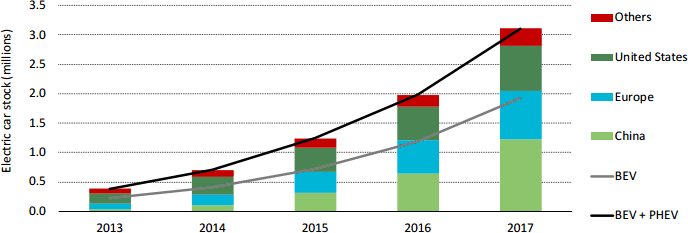Global electric vehicle population reaches 3 million
30 May 2018
The number of battery electric (BEV) and plug-in hybrid (PHEV) cars on the world’s roads exceeded 3 million in 2017, a 54% increase compared with 2016, according to the latest edition of the International Energy Agency’s Global Electric Vehicles Outlook.
China remained by far the largest electric car market in the world, accounting for half sold last year. Nearly 580,000 electric cars were sold in China in 2017, a 72% increase from the previous year. The United States had the second-highest, with about 280,000 cars sold in 2017, up from 160,000 in 2016.


Nordic countries remain leaders in market share. Electric cars accounted for 39% of new car sales in Norway, making it the world leader in electric vehicle (EV) market share. In Iceland, new EV sales were 12% of the total while the share reached 6% in Sweden. Germany and Japan also saw strong growth, with sales more than doubling in both countries from their 2016 levels.
In addition to cars, electric mobility has entered the urban bus and two-wheel vehicle markets—the electrification of these modes of transport has been driven almost entirely by China, which accounts for more than 99% of both electric bus and two-wheeler stock. In 2017, the stock of electric buses rose by 7.2%, reaching 370,000 from 345,000 in 2016, and electric two-wheelers reached 250 million.
Energy Demand & Infrastructure. So far, the expanding numbers of EVs have had limited impact on electricity demand thus providing encouraging signs for the adoption of electric vehicles. The electricity demand from EVs was equivalent to 0.2% of the total global electricity consumption in 2017, according to IEA estimates. In China and Norway, the countries that have respectively the largest fleet and the largest market share of EVs, EV electricity demand is 0.45% and 0.78% of the total demand.
In 2017, the estimated global electricity demand from all EVs was 54 TWh. Most demand (91%) is located in China, where the consumption is mostly due to two-wheelers and buses. These two modes combined accounted for 87% of EV electricity demand worldwide.
In 2017, the number of private chargers at homes and workplaces was estimated at almost 3 million worldwide. In addition, there were about 430,000 publicly accessible chargers worldwide in 2017, a quarter of which were fast chargers. Fast chargers are especially important in densely populated cities and serve an essential role in boosting the appeal of EVs by enabling long-distance travel.
EV Growth Drivers. The growth of EVs has largely been driven by government policy, including public procurement programs, financial incentives reducing the cost of purchase of EVs, tightened fuel-economy standards and regulations on the emission of local pollutants, low- and zero-emission vehicle mandates and a variety of local measures, such as restrictions on the circulation of vehicles based on their pollutant emission performances.
The uptake of EVs has also been helped by progress made to improve the performance and reduce the costs of lithium-ion batteries. However, further battery cost reductions and performance improvements are essential to improve the appeal of EVs, stated the IEA.
Innovations in battery chemistry will also be needed to maintain growth as there are supply issues with core elements that make up lithium-ion batteries, such as nickel, lithium and cobalt. The supply of cobalt is particularly subject to risks as almost 60% of the global production of cobalt is currently concentrated in the Democratic Republic of Congo. Additionally, the capacity to refine and process raw cobalt is highly concentrated in China, who controls 90% of refining capacity. Cobalt demand for EVs is expected to be between 10 and 25 times higher than current levels by 2030.
Looking forward, the IEA expects that supportive policies and cost reductions are likely to lead to continued significant growth in the EV market. In the IEA’s New Policies Scenario, which takes into account current and planned policies, the number of electric cars is projected to reach 125 million units by 2030.
Source: IEA